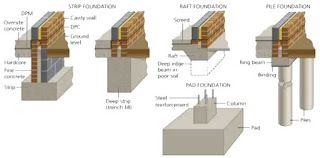Different Types of Foundation
- To distribute the load of the structure over a large bearing area.
- To load the bearing surface at uniform rate so as to avoid unequal settlement.
- To prevent the lateral movement of the supporting material.
- To increase the stability of the structure as a whole.
Shallow FoundationFactors affecting the selection of Foundation
Wall FootingIsolated column/Column FootingCombined FootingCantilever (Strap) FootingMat (Raft) FoundationDeep Foundation
Pile FoundationPier FoundationWell (Caissons) Foundation
Foundation are classified on the basis of load transmission to the ground into two sub-categories i.e. shallow foundation and deep foundation.
Shallow Foundation
Shallow foundation are those foundations in which the depth at which the foundation is placed is less than the width of the foundation (D < B). Shallow foundations are generally termed as spread footing as they transmit the load of the super structure laterally into the ground.
Classification of Shallow Foundation:
On the basis of design, the shallow foundation are classified as:
Wall FootingIsolated column or Column FootingCombined FootingCantilever (Strap) FootingMat (Raft) FoundationWall Footing
This type of foundation runs continuous along the direction of the wall and helps to transmit the load of the wall into the ground. Wall footing are suitable where loads to be transmitted are small and are economical in dense sands and gravels. In this type of foundation the width is 2-3 times the width of the wall at ground level. Wall footing may be constructed through stone, brick, plain or reinforced cement concrete.
Column Footing
Column footing are suitable and economical for the depth greater than 1.5m. In this type of foundation the base of the column is enlarged. Column footing is in the form of flat slab and may be constructed through plain or reinforced concrete.
Combined Footing
Combined footings are those foundations that are made common for two or more columns in a row. It is used when the footing for a column may extend beyond the property line. It is also suitable when the two columns are closely spaced and the soil on which the structure resist is of low bearing capacity. It may be rectangular or trapezoidal in shape.
Strap Footing
When an edge footing cannot be extended beyond the property line the edge footing is linked up with the other interior footing by means of a strap beam. Such footings are called as strap footing. It is also know as cantilever footing.
Mat Foundation
A mat foundation is a combined footing which covers the entire area beneath of a structure and supports all the walls and columns. It is also known as raft foundation. Mat foundation is applicable when:
- Allowable bearing pressure is low.
- The structure is heavy.
- The site is with highly compressible layer.
The mat foundation can be further classified into following types:
- Flat slab type.
- Flat Slab thickened under column.
- Two way beam and slab type.
- Flat slab with pedestals.
- Rigid frame mat.
- Piled mat.
Deep Foundation are those foundations in which the depth of the foundation is greater than its width (D>B). The D/B ratio is usually 4-5 for deep foundation. Unlike shallow foundation, the deep foundation transmits the load of the superstructure vertically to the rock strata lying deep. Deep foundations are used when the shallow foundation cannot support the load of the structure.
Classification of Deep Foundation
The mat foundation can be further classified into following types:
Pile FoundationPier FoundationWell (Caissons) Foundation
Pile Foundation
Pile is a slender member with small area of cross-section relative to its length. They can transfer load either by friction or by bearing. Pile foundation are used when:
- The load is to be transferred to stronger or less compressible stratum, preferably rock.
- The granular soils need to be compacted.
- The horizontal and the inclined forces need to be carried from the bridge abutments and the retaining walls.
Classification of Pile Foundation
The pile foundation can be further classified into following types on various basis such as function, material, method of installation which are listed below:
Based on Function:
Bearing pilesFriction pilesCombined piles (Both bearing and friction)Based on Material:
Timber pilesConcrete pilesSteel pilesBased on Method of Installation:
Large displacement pilesSmall displacement pilesNon-displacement piles
Pier Foundation
Pier foundation are underground cylindrical structural member that support heavier load of the structure which shallow foundations cannot resist. Unlike pile foundation, pier foundation can only transfer load by bearing. Pier foundation are shallower in depth than the pile foundation. Pier foundation are used when:
- The top strata is a decomposed rock underlying as sound rock strata.
- The soil is a stiff clay that occurs large resistance for driving the bearing pile.
Well (Caissons) Foundation
The term caisson refers to box or a case. These are hollow inside and are usually constructed at the site and sunk in place into a hard bearing strata. As they are expensive in construction, they are usually restricted to major foundation works. Well foundation are suitable when the soil contains large boulders obstructing the penetration during installation of pier or pile foundations. Caissons are used for bridge piers, abutments in rivers and lakes and other shore protection works. They are used to resist heavy vertical and horizontal loads and are used in the construction of large water front structures as pump houses.
Classification of Well Foundation
Open Caissons
Pneumatic Caissons
Box Caissons
Factors affecting the selection of Foundation:
On the basis of ground/soil condition
- Shallow foundations are preferred where soil close to the surface is capable of supporting structure loads.
- Where the ground close to the surface is not capable of supporting structural loads, hard strata is searched for and deep foundation is required.
- Uniform stable ground requires relatively shallow foundation whereas filled up ground has low bearing capacity thus requires deep foundation.



0 comments:
Post a Comment